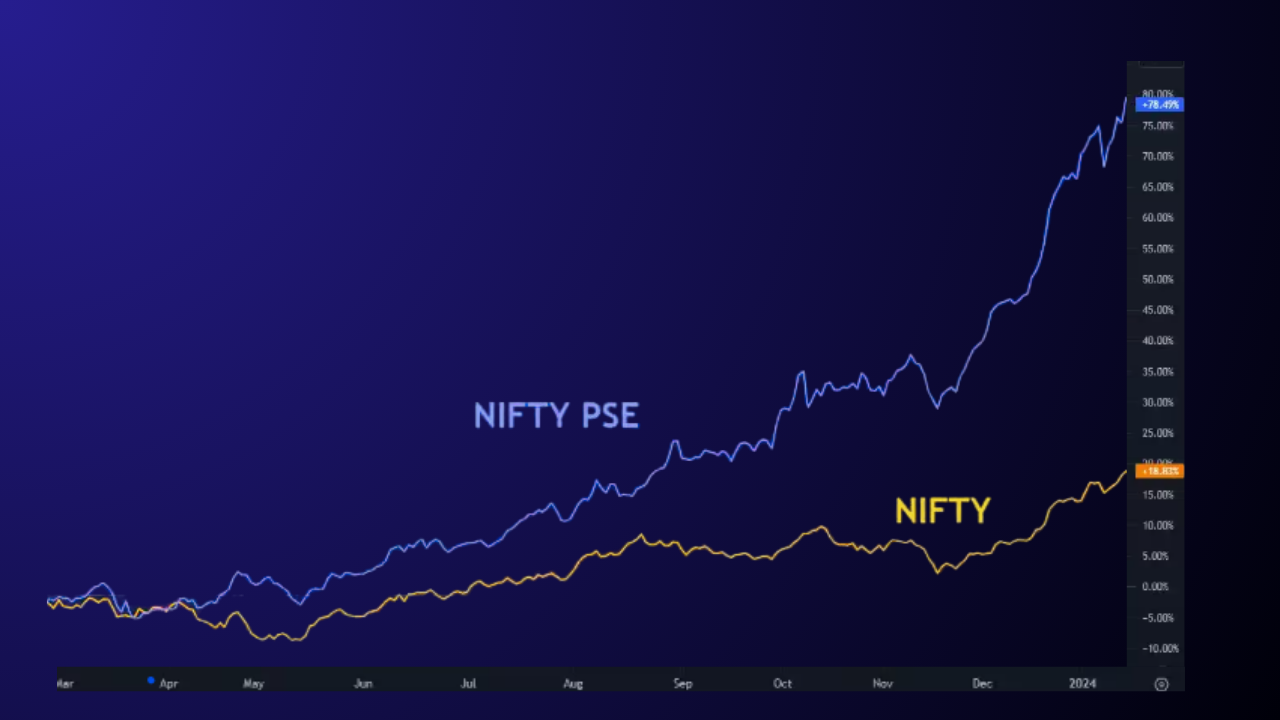
04 Jan Why PSU Stocks Are on Fire? Are PSU Overvalued?
PSU Stocks Rally: What’s Fueling the Surge?
In 2023, Public Sector Undertaking (PSU) stocks took the stock market stage by storm, outshining the benchmark Nifty index. The Nifty PSE index soared by a whopping 79%, leaving the benchmark Nifty trailing at 19.8% in 2023.
Astonishingly, one in three PSU stocks on the BSE PSU index delivered returns exceeding 100%.
What is NIFTY PSE?
The NIFTY PSE (Public Sector Enterprises) is a thematic index on the National Stock Exchange (NSE) that aims to reflect the performance of Indian public sector enterprises in real-time. This index is comprised of 20 stocks, and these companies must have at least 51% of their share capital owned by the central and/or state government, either directly or indirectly.
The NIFTY PSE index serves as a benchmark for tracking the performance of public sector enterprises in the Indian stock market.
PSE stands for “Public Sector Enterprises.” These are businesses under government ownership, enjoying government support. They often have a quasi-monopolistic status, playing a significant role in the market, which can impact their valuation positively.
Also Read: “Ircon International: On Track with Big Plans?”

Here’s the breakdown of what’s been driving this rally:
Transformations in Business Strategies:
- Public sector companies adapted to changing dynamics. For instance, BHEL shifted focus from coal-based power equipment to supplying railway and defence equipment, riding the bull run.
Political Influence:
- The recent surge post-November is linked to the ruling BJP government’s victories in three crucial state elections.
- Market anticipates government continuity and support, with potential shorting opportunities if election results differ from expectations.
Also Read:IRCTC Shares close to Rs 900! What Next?”
Defence and Railway Sectors Shine:
- Defence and railway sectors witnessed robust performance, attracting investor interest.
- Entry of more public sector defence and railway companies into the market, coupled with limited floating stock, propelled the upward movement.
- Government initiatives like Atmanirbhar Bharat and Make in India contributed to this surge.
Atmanirbhar Bharat Impact:
- The government’s Atmanirbhar Bharat initiative and Make in India program yielded positive results, boosting the performance of PSU companies.
- Increased government spending and orders, especially in the run-up to elections, fueled the rally.
Also Read: “From Crisis to Confidence: YES Bank’s Journey to Stability”
PSU Banks: Resilient Resurgence
Surprising investors, PSU banks are on a remarkable upswing, boasting improved operating parameters.
Motilal Oswal’s report predicts a sustained earnings boost from enhanced loan growth, stable margins, and controlled credit costs.
PSU banks are undergoing rerating, surpassing expectations by leveraging their traditional base and making bold strides into retail banking. This resilient resurgence signifies not just financial prowess but also strategic adaptability, positioning PSU banks for a dynamic future.
Some Caution Flags:
- Despite the surge, caution is advised as some PSU stocks have outpaced their valuation.
- Defence stocks trade at a 50% premium, while railway stocks are at the upper band of their historical valuation.
Also Read: The Remarkable Turnaround of JLR: From Tata’s “Biggest Mistake” to a “Biggest Victory”

Are PSU Stocks Getting Expensive? Let’s Explore the Numbers
Nifty PSE in the Last 10 Years:
- Current PE: 9x
- Average Gain: +13%
- Average EPS: 400
- Average PE: 10x
Returns:
- 2023: +80%
- 2022: +6%
- 2021: +53%
- 2020: -10%
- 2019: -6%
- 2018: -25%
- 2017: +7%
- 2016: +35%
- 2015: -18%
- 2014: +44%
- 2013: -18%
PE Year-wise:
- 2023: 9x
- 2022: 8x
- 2021: 6x
- 2020: 10x
- 2019: 9x
- 2018: 10x
- 2017: 15x
- 2016: 14x
- 2015: 11x
- 2014: 12x
- 2013: 8x
Amidst the PSU stocks’ 2023 surge, investors should diversify strategically knowing political influences and sector-specific performances. Understand the long-term narrative, navigate political landscapes, and evaluate risk-reward ratios for informed investment decisions. In this dynamic market, adaptability, sector awareness, and cautious optimism form the pillars of a well-informed investor strategy.
Please note that we are not SEBI-registered advisors or analysts. All the views shared in this article and all the content shared on aceink.com are only for learning and educational purposes. Any part of the article or any information on Aceink.com should not be interpreted or considered as investment advice. None of the opinions, views, or content posted on Aceink.com constitutes investment advice, as we are not SEBI-registered advisors or analysts.
DISCLAIMER:
We are not SEBI-registered advisors or analysts. All the views shared in this article and all the content shared on aceink.com are only for learning and educational purposes. Any part of the article or any information on Aceink.com should not be interpreted or considered as investment advice. None of the opinions, views, or content posted on Aceink.com constitutes investment advice, as we are not SEBI-registered advisors or analysts.
Aceink.com or any person associated with this website accepts no liability or responsibility for any direct, indirect, implied, or any other consequential damages arising directly or indirectly due to any action taken based on the information provided on this website. Please conduct your own research, and we suggest seeking investment advice only from a SEBI-registered investment advisor.
The views expressed by investment experts, broking houses, news and media houses, rating agencies, etc., are their own and not those of Aceink.com or its management. Aceink.com advises users to consult a SEBI-registered investment advisor before making any decisions.






No Comments